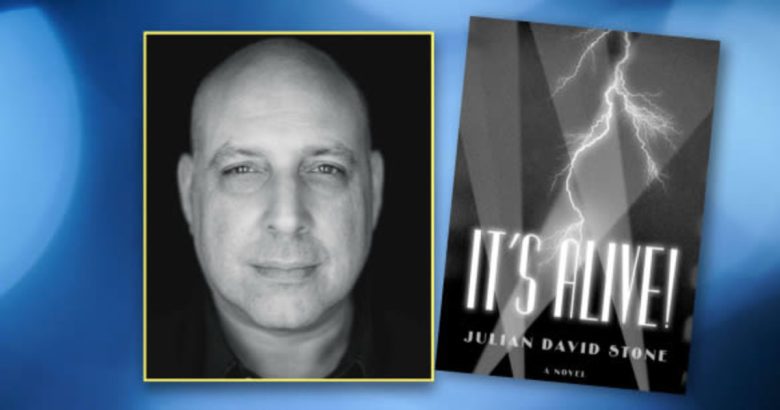Reviewed by Eric Lindbom.
The classic Universal horrors of the ‘30s and ‘40s are rightly celebrated by historians and fans whose adoration transcends the marquee lead actors who played the immortal monsters. We rabid buffs also drool over key supporting players like mad doctors Lionel Atwill, George Zucco and John Carradine and scream queen Evelyn Ankers, make up master Jack Pierce, screenwriter Curt Siodmak and special effects innovator John Fulton.
Yet, author Julian David Stone makes a passionate and utterly compelling case for an often unsung hero of the ‘30s cycle and arguably the inventor of the horror film genre – prescient studio boss Carl Laemmle Jr. who in his early twenties (!) ran the studio his father built. IT’S ALIVE! (Greenleaf Group Press), Stone’s deeply researched, addictive novel, zones in on the three fitful days before director James Whale rolled the cameras on Frankenstein.
Stone discussed the novel, and the life of Junior (as all called him), with a rapt audience at a sold out appearance at the Hollywood Heritage Museum, a must-see stop for silent film buffs that’s filled with movie memorabilia. (Located across from Hollywood Bowl, it’s housed in the restored Lasky-DeMille Barn, the studio where D.W Griffith filmed the 1914 western feature The Squaw Man; check out www.hollywoodheritage.org for info).
In the transitional, early talkie period, Junior sought to make Universal a forward-thinking studio. He acquired key literary IP like the eventual Oscar-winning All Quiet on the Western Front and single-handedly pushed for film versions of Bram Stoker’s Dracula and Mary Shelley’s Frankenstein. While Universal enjoyed silent success with Lon Chaney as The Phantom of the Opera and The Hunchback of Notre Dame, the term ‘horror movie’ didn’t exist at the time, Stone explained. Those prestige melodramas weren’t deemed as ghoulish as his pet projects and Junior battled fierce resistance from industry insiders including Carl Senior, an innovative film distributor who invented studio tours but specialized in quaint material (corny in his son’s eyes).
The novel trenchantly paints Junior as a brash, cheerful gambler and serial dater ever looking ahead. In an early chapter, he dresses down two screenwriters who pitch a by-the-numbers musical scenario. “As long as I’m in charge here at Universal, we don’t do that sort of thing anymore. We do new things. Exciting things. Things that have never been before.” Indeed, contemporary audiences were shell shocked and thrilled by the now iconic monsters Universal unveiled at Junior’s urging.
Many know Hungarian matinee idol Bela Lugosi, hot off his hypnotically seductive take as Dracula, famously turned down the follow up role of the monster due to its lack of dialogue. What Stone conveys in these tense pages is the back-and-forth vacillations as Junior pivoted between casting his newly minted star Lugosi (who appeared in make up as the monster in a long lost screen test) and Boris Karloff a then starving character actor approaching middle age and mired in minor thug roles, who Whale discovered in the studio commissary.
The novel breathlessly follows Junior’s frenetic juggling and the resulting triangulations between the desperate Karloff, proud Lugosi, irritated, jostled director Whale and bridesmaid Robert Florey (who ended up helming the Expressionistic but creaky Poe adaptation Murders in the Rue Morgue which gave Lugosi his pages of desired dialogue as deranged evolutionist Dr. Mirakle who seeks to mix gorilla blood with humans). The peripatetic Junior maintains a harried, upbeat façade amidst accelerating anxiety attacks. Meanwhile, Stone sprinkles in catnip for we true believers including a chorus line musical number where the dancers approximate the now beloved Universal ‘30s logo with its puttering biplane circling the earth.
Stone theorizes that the Frankenstein story held personal appeal to Junior as a father son drama, with dad Dr. Frankenstein (the feverishly messianic Colin Clive) abandoning the ‘frightened child’ son he birthed and that Karloff brought to life with such murderous poignancy. The role of course cemented Karloff’s legacy as king of the monsters, while forcing Lugosi into deliciously evil roles often in Karloff’s formidable shadow.
Fans know that Lugosi (in his hungrier ‘40s decade) was reduced to playing the monster in Frankenstein Meets the Wolf Man, staggering clumsily since the character was blind early on; this fact didn’t survive the cutting room floor so only audiences with a fresh memory of Ghost of Frankenstein had any idea what Lugosi struggled fitfully to convey.
By this time, as Stone told the museum audience, Junior’s career was long gone from Universal after the Laemmles lost ownership of their studio. Junior ended up in development hell after an ill-advised executive move to MGM that resulted in no green lit pictures. In his latter years, he still threw lavish parties (attended by luminaries like French director Jean Renoir) even while bed ridden with multiple sclerosis.
With IT’S ALIVE! Stone shines a deserved klieg light on Junior with page turning verve and dollops of humor throughout. For more information on the book and author, check www.JulianDavidStone.com.
Eric Lindbom is a hardcore horror buff with a strong stomach, weaned on the Universal classics from the ’30s and ’40s. He’s written film and/or music reviews for City Pages, Twin Cities Reader, LA WEEKLY, Request magazine and Netflix. He co-edits triggerwarningshortfiction.com, a site specializing in horror, fantasy and crime short stories with illustrations by co-editor John Skewes. He lives in Los Angeles.







